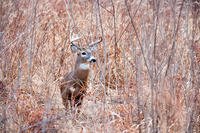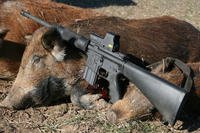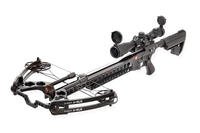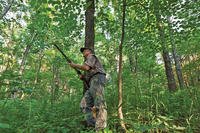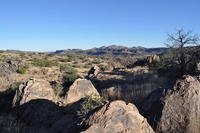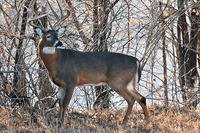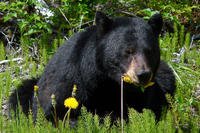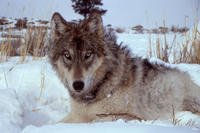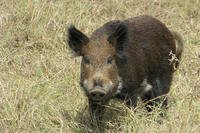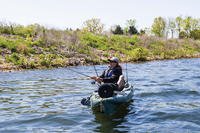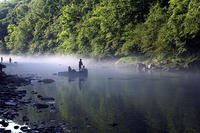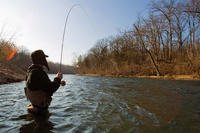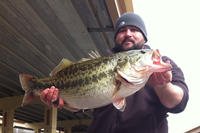Match your techniques to the coyote’s life cycle for maximum success.
by Emory Josey
Unless I'm after a rogue coyote, I leave them alone while they raise their young. In Georgia, that means little or no coyote hunting during May, June and July. After that, the pups are almost as large as the adults, capable of surviving on their own. This still leaves a part of spring and summer and all of fall and winter to hunt. Different seasons require different tactics for successful coyote hunting. Be prepared to switch tactics as the need arises to maximize your hunting efforts.
Late Summer
The fur never primes in the South and is practically worthless, so that is never a consideration. In August, however, young of the year are hunting with their parents – some going it alone. It's the perfect time for a beginner to learn coyote hunting because it's at this time that one will encounter the dumbest coyotes of the year. I say that tongue-in-cheek since even young coyotes are very intelligent and born with an enormous amount of survival instinct. By the time the young have hunted with the adults for a few weeks, they have accumulated a plethora of instinctive stop signs.
Coyote families are territorial during the summer months, staying closer to the dens than other seasons. After the pups near physical maturity, they might not return to the dens at all, but usually hunt the same general area because this is where they have been trained and the territory is familiar. Considering this, coyotes are likely to be near where you discovered den activity or heard howling and yipping earlier in the year.
Ringing The Dinner Bell
Prey-distress sounds work well during late summer and early fall. Despite being overused, rabbitdistress is still the "go-to" sound and is probably the most effective prey distress for young coyotes. Rabbits are prolific in summer and the coyote pups have likely heard many rabbits scream. Even ifMom and Dad are with them, a pup will likely leave the group and head straight for what sounds like a hot meal. If the mother has been duped before, she might try to head Junior off at the pass but the youngster can now run 35 mph, so he can often get in trouble before Mama can stop him. A really strict Mom might have bitten his flanks for being too aggressive toward what she thought to be a ruse. Such a pup might wait for Mama to check out the source.
Multiple Visitors
Either way, the hunter is likely to have a chance for a double — or more. Last September, I saw four flashes of fur come out of a thick head of timber into an open hay field. One coyote looked larger then the other three and I surmised it was the female parent. Not as eager as the other three, she lagged behind. The cross-wind was good and they were headed for a decoy, so I waited. When the three youngsters were 75 yards out, Mama was still 150 yards away and she stopped, turning broadside; a red flag that she smelled trouble. I remembered what my old friend Murry Burnham once told me, "Take the female first, even if she is at a longer distance." The .204 barked and the female went down. The other three simply milled around and I was able to take two of them before the fourth one bolted — and I missed. No matter, I had my first true triple.
Other Sounds
Howling can be effective all year, but for late summer other sounds work better. The one exception is the lone-pup howl, a high-pitched replica of a single pup that is lost, lonesome or nervous. Any adult coyote is vulnerable to this sound even if all the pups of the litter are present. Seemingly brilliant, coyotes can't count.
Pup distress is good all year, but especially productive when the family group is still intact. Adults, male or female, that have lost their pups will come to pup-distress cries.
Mammals or birds, the young of the year are abundant now. Bird distress imitations are very effective and offer a new sound where the rabbit has been overused. Among my favorites are woodpeckers, blue jays and cardinals.
The most productive set-up I have used this year enlisted the help of a new decoy. Flambeau has a new fake fawn that is superb. Slightly smaller than the average fawn decoy, it is also lightweight, durable, flexible and easy to carry. The new metal stake insert solves the problem of hard ground. Coyotes instinctively know when it's time for deer to begin dropping fawns. The faux fawn, sprayed with fawn urine and coupled with an electronic caller singing a fawn distress song is deadly. Even when the fawns had lost their spots and turned into yearlings, this decoy was still fooling coyotes.
Hot Weather Precautions
Totally fooling the coyote's nose is impossible. You can, however, confuse it long enough to get a shot. The warmer the temperature, the more you sweat and the more human odor is carried on the wind. Scent control is critical at any season, but far more in summer and early fall. I believe the secret — if there is one — is to accept the fact that a coyote is going to smell you no matter what. Do everything you can to keep the coyote from determining if the human odor is fresh. Many coyotes come in contact with human scent every day. By "misting" (see SCENT CONFUSION, P-Xtreme, August 2007) and using good personal hygiene, you can confuse the coyote's nose for a short time. Hopefully, long enough to get one good shot!
To guard against diseases that are carried by ticks and mosquitoes, hot weather hunters must use an insect repellent. Use mosquito repellents that have a special scent, specifically designed for controlling foreign odors. For ticks and chiggers, spray your clothes with Permanone and allow them to dry before putting them on. This product should never be used directly on the skin. Permanone will last for several days and does not carry an odor that will deter coyotes.
When To Call
When daytime temperatures are from 80 to 100 degrees, coyotes wait until it cools off to hunt. Sure, I have had them come running at high noon in triple-digit temperatures, but they are far more likely to cooperate when it's cooler. In winter, I hunt all day, but in hot weather, I suggest the first two and last two hours of daylight with the morning getting the nod. On morning hunts, be in your set-up at or before first shooting light.
Foliage is thick and this dampens sound. Space set-ups closer together and use open areas to draw the coyotes out. Many times shotguns are more prudent for summer calling.
Late Fall/Early Winter
Pups are now hard to distinguish from adults, physically. Mentally, they are still teenagers. While they can still be in social contact with the parents, they often hunt alone or with siblings. With breeding season only weeks away, some seem to sense that they might soon be banished from the family. The more aggressive ones will have dispersed and will be transients until they establish a new territory. This canbe some of the best hunting of the year for the predator hunter.
The lone-pup howl that worked so well in calling Mama in the summer now works equally well in calling other young of the year. Challenge howls don't usually get results with young coyotes, but are great for calling in the Alpha male. All prey-distress sounds are now effective, but switch them around so the dogs that have been overcalled don't get too wise too soon.
Change Camo
Foliage is scarce or non-existent and it's time to change camouflage patterns. The pattern that worked well in summer can now stick out like the proverbial thumb. Research continues about exactly how a coyote sees a camouflaged hunter and you can benefit from these findings. I was amazed at how ineffective my camouflage was. Now I pay more attention.
Late Winter/Early Spring
This is my favorite time to hunt coyotes. Georgia's split deer seasons end on January 1 and 15. It's getting colder and the hunters are scarce. It's easier to gain access to hunting land. Young coyotes, except for the select few that are allowed to stay with the pack, have been chased into the fringe territories and are on their own. Prey species are harder to find and the dogs are hungry. This is when coyotes with lesser intelligence get sent to the gut pile in the sky. Prey distress and howling both work well.
Then there comes a lull in the action. Fewer coyotes respond, for two reasons. First, the dumb ones are dead. Second, mating season is near and adult dogs begin to have higher hormone levels. They become less interested in food and more interested in propagating the species.
Being a proponent of coyote vocalization, I rely more on howling during this season. I might begin with a low volume prey distress, but I'll never leave a set without howling two or three times. My first attempt will be a female invitation. After a long wait and no takers, I end up with a challenge howl and another long wait. I might stay on a set for an hour. I have had some old males show up after 30 minutes of silence.
During this season, some males and females have already paired up. It is not uncommon to call in a pair. The male will usually appear first. If it is feasible, don't be in a rush to shoot. You shouldn't wait so long that you lose a shot opportunity, but give the female a chance to show up. Being more timid than the male, she lags behind. If she does show, shoot her first and then the male. IF your set-up is good AND the wind is right, IF you have correctly guessed the direction the dogs will come from AND you are misting, you have a good chance of scoring a double.
Cold Weather Precautions
With sparse foliage, the hunter has a better range of vision but it's harder to hide. Even so, with good camouflage and a sensible set-up, you can fool the coyote's eyes. It is critical that you do not move when the coyote is approaching and looking in your direction. Decoys placed near an e-caller help to draw the coyote's attention away from your hideout.
Watch the prevailing breeze. When possible, use a cross wind with a decoy to keep the coyote's path in a direction that will not get you busted. While cold air dampens the coyote's olfactory effectiveness, snow enhances it, and that nose still works very well.
In Eastern woods, calling from deer stands adds new dimensions to coyote calling. The added elevation allows you to see farther as well as helping to keep your scent cone high in the air.
Whatever the season, I still rely on misting. This concept keeps multiple scents on the prevailing breeze. The scents do not cover human odor, but they are very effective in bombarding the coyote's near-perfect nose with enough different smells to confuse its brain.
All-Season Tips
Practice shooting with a good set of shooting sticks. These are available in lightweight camouflaged models that are easy to carry. Use of this tool greatly improves accuracy and your kill percentage.
Wind direction is critical, but so is the shooting direction of your set-up in relation to the sun. When possible, set up with the sun to your back and the wind in your face, or a cross-wind. If this isn't possible, it's often better to leave the spot and hunt it another time when both wind and sun are right. Using marginal set ups will get you busted, and only serve to educate coyotes.
Summing It Up
There are many coyote hunters who hunt as I did in my early years. They simply put on camo, grab a manual caller and a firearm and go. They'll kill a few coyotes, but they could do much better.
Admittedly, taking along e-callers, multiple decoys, shooting sticks, misting bottles, etc., can slow you down, but use of these assets, along with modifying your tactics to fit the seasonal changes of coyote habits can up your score.
Porath's Dazed Dog Coyote Mist is a winner, but that white bottle needs a camouflage job. You do need to sweat the small stuff. I use camouflage tape on one bottle. When the bottle is empty, simply transfer contents of a new bottle – including a new spray head – to the original bottle with camouflage. Perhaps, in the future, Porath will camouflage all his bottles.
